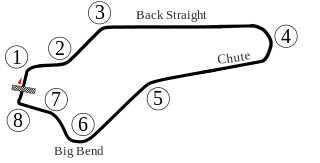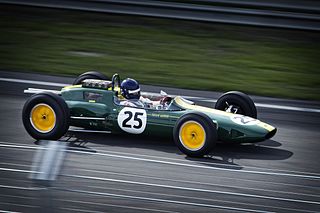
The 1962 United States Grand Prix was a Formula One motor race held on October 7, 1962, at the Watkins Glen Grand Prix Race Course in Watkins Glen, New York. It was race 8 of 9 in both the 1962 World Championship of Drivers and the 1962 International Cup for Formula One Manufacturers. The 100-lap race was won by Lotus driver Jim Clark after starting from pole position. Graham Hill finished second for the BRM team and Cooper driver Bruce McLaren came in third.

The 1961 Formula One season was the 15th season of Formula One motor racing. It featured the 1961 World Championship of Drivers and the 1961 International Cup for F1 Manufacturers, which were contested concurrently from 14 May to 8 October over an eight race series. The season also included numerous non-championship races for Formula One cars.

The Lotus 25 was a racing car designed by Colin Chapman for the 1962 Formula One season. It was a revolutionary design, the first fully stressed monocoque chassis to appear in Formula One. In the hands of Jim Clark it took 14 World Championship Grand Prix wins and propelled him to his 1963 World Championship title. Its last World Championship win was at the 1965 French Grand Prix.

The Lotus 49 was a Formula One racing car designed by Colin Chapman and Maurice Philippe for the 1967 F1 season. It was designed around the Cosworth DFV engine that would power most of the Formula One grid through the 1970s. It was one of the first F1 cars to use a stressed member engine combined with a monocoque to reduce weight, with other teams adopting the concept after its success. It also pioneered the use of aerofoils to generate downforce.

The Lotus 33 was a Formula One car designed by Colin Chapman and Len Terry and built by Team Lotus. A development of the successful Lotus 25, in the hands of Jim Clark it won five World Championship Grands Prix in 1965, taking Clark to his second World Championship.

The 1961 South African Grand Prix, formally titled the 8th International RAC South African Grand Prix, was a non-championship Formula One motor race held at Prince George Circuit, East London, South Africa on 26 December 1961. The race, run over 80 laps of the circuit, was won from pole position by Scotland's Jim Clark, driving a works Lotus-Climax. Englishman Stirling Moss finished second in a private Lotus-Climax, while Swede Jo Bonnier was third in a Porsche.

The 21st Pau Grand Prix was a non-Championship motor race, run to Formula One rules, held on 3 April 1961 at Pau Circuit, the street circuit in Pau. The race was run over 100 laps of the circuit, and was won by Jim Clark in a Lotus 18. This was Clark's first Formula One victory.
The 9th Gold Cup was a motor race, run for Formula One cars, held on 1 September 1962 at Oulton Park, England. The race was run over 73 laps of the circuit, and was won by British driver Jim Clark in a Lotus 25.
The 8th Kanonloppet was a motor race, run for Formula One cars, held on 12 August 1962 at the Karlskoga circuit, Sweden. The race was run over 30 laps of the little circuit, and was won by American driver Masten Gregory in a Lotus 24, run by the UDT Laystall Racing Team.
The 9th Kanonloppet was a motor race, run to Formula One rules, held on 11 August 1963 at the Karlskoga Circuit, Sweden. The race was run over two heats of 20 laps of the little circuit, and was won by British driver Jim Clark in a Lotus 25.

The 5th Rand Grand Prix was a motor race, run to Formula One rules, held on 15 December 1962 at Kyalami, South Africa. The race was run over 50 laps of the circuit, and was won by British driver Jim Clark, who led from start to finish in his Lotus 25.

The 7th Aintree 200 was a Formula One motor race held on 28 April 1962 at Aintree Circuit, Merseyside. The race was run over 50 laps of the circuit, and was won by British driver Jim Clark in a Lotus 24-Climax. Clark also set pole position and fastest lap. Bruce McLaren in a Cooper-Climax was second and Ferrari driver Phil Hill was third.

The 9th Aintree 200 was a Formula One motor race held on 18 April 1964 at Aintree Circuit, Merseyside. The race was run over 67 laps of the circuit, and was won by Australian driver Jack Brabham in a Brabham BT7-Climax. BRM driver Graham Hill started from pole position and finished second, and Lotus driver Peter Arundell was third. Arundell's team mate Jim Clark set fastest lap.

The 14th Lavant Cup was a motor race, run for Formula One cars, held on 23 April 1962 at Goodwood Circuit, England. The race was run over 21 laps of the circuit, and was won by New Zealand driver Bruce McLaren in a Cooper T55.

The 2nd Daily Mirror Trophy was a motor race, run to Formula One rules, held on 14 March 1964 at Snetterton Motor Racing Circuit, England. The race was run over 35 laps of the circuit, and was won by British driver Innes Ireland in a BRP.

The 5th Cape Grand Prix was a motor race, run to South African Formula One-style rules, held on 2 January 1962 at Killarney Motor Racing Complex, Cape Town, South Africa. The race was run over 60 laps of the circuit, and was won by British driver Trevor Taylor, in his Lotus 21.
The 1st Natal Grand Prix was a motor race, run to South African Formula One-style rules, held on 17 December 1961 at Westmead Circuit, South Africa. The race was run over 89 laps of the circuit, and was won by British driver Jim Clark, in his Lotus 21.
The 2nd Natal Grand Prix was a motor race, run to South African Formula One-style rules, held on 22 December 1962 at Westmead Circuit, South Africa. The field was split into two heats, with a subsequent final. The heats consisted of 22 laps, and the final was run over 33 laps, and was won by British driver Trevor Taylor in his Lotus 25.

The Flugplatzrennen was a motor race, run for cars complying with Formula One rules, held on 17 September 1961 at Zeltweg Airfield, Austria. The race was run over 80 laps of the circuit, and was dominated by British driver Innes Ireland in a Lotus 21.

The Brabham BT3 is a Formula One racing car. It was the first Formula One design to be produced by Motor Racing Developments for the Brabham Racing Organisation, and debuted at the 1962 German Grand Prix. The Brabham BT3 was the vehicle with which team owner – then two-time World Champion – Jack Brabham, became the first driver ever to score World Championship points in a car bearing his own name, at the 1962 United States Grand Prix. The following year Brabham also became the first driver ever to win a Formula One race at the wheel of an eponymous car, again driving the BT3, at the 1963 Solitude Grand Prix. The BT3 design was modified only slightly to form the Tasman Series-specification Brabham BT4 cars.














